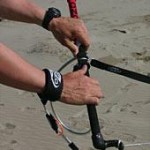My name is William, I am 31 years old, and I am an addict. If I see the slightest movement in the trees I find myself drawn to a field or a hard packed beach. I am a kite groundboarder.
I grew up in the 80’s on skateboards and snowboards spending my free time trying to “get some air”. If skateboarding and snowboarding gave me just a taste of airtime, kite groundboarding provided me with an all you can eat buffet… You may be asking yourself what is this 31 year old manchild doing riding around on an overgrown skateboard. You may be surprised to hear that I am one of the younger riders. Many of the riders recently polled were in their late 30’s with riders ranging from 12 to 57 years of age.
Kite groundboarding is a very young sport. So young in fact that a single name has not been decided for it yet. It goes by kite groundboarding (KGB), kite all terrain boarding (kiteatb), kitemountainboarding, and landboarding. The sports current riders, will someday be considered the pioneers of the sport.
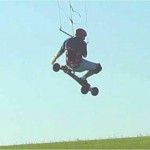
Not sure what the sport is all about yet? Do an internet search using names like Gabe Shortman, Eli Anderson and Brian Schenck of America, Goshen Watts of Australia, Vince Coleman and Mark Somerville of the UK. You are most likely to find videos and pictures of these guys flying high, spinning, grinding, sliding, and even flipping. Their hang times are impressive; their control over obscene amounts of harnessed wind power is even more impressive. If these guys don’t inspire the addiction, chances are nothing will.
I originally bought the mountainboard to gain the skills needed for kitesurfing. After a few months of Kite groundboarding, I no longer had the desire to carry the sport into water. Many of the tricks I had previously thought insane over water I was now attempting over land. Sure it isn’t as safe as flying a Delta. It is true some riders have been known to snap a collar bone or sprain and ankle, but overall the danger is manageable with the proper skills and awareness of ones environment. If you keep it on the safe side, the risk is minimal. I have been bruised and dragged down field once or twice. After a bad landing the ego usually is hurt more than anything.
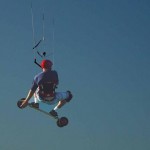
How to manage the danger. The first step is to understand your kite. I learned this by paying my dues on smaller kite, 1.5- 2.0 square meters will do. A kite this size will give enough pull to keep you interested, but in low winds it won’t send you unintentionally flying. It is most important to know and understand what a kite will do in any given spot in the wind window before you place it there. Also understanding what your kites wind range is and strictly following it will reduce the danger of flying uncontrolled and overpowered.
The next step is accessing your skill. A kites wind range may be 8-20 mph, however the high end of the range may be very tough to handle for the beginner. By flying the kite in the lower end of its range first and progressing to the higher wind speeds with time, you may avoid serious injury.
Safety equipment:
Know it and use it. Most kites have built in safety devices to instantly depower the kite or detach from it. Knowing blindly where these devices are and trying them before they are needed will pay off.
I use a skateboarding helmet, elbow and knee pads. I have found the knee pads do more to save my skin than anything else. Using larger skate style knee pads made by Pro-tec I feel comfortable landing on my knees and sliding out of a problem. If you are going too fast and lose control, jumping off and running is not an option. This mistake is what causes ankle injuries, and could lead to broken limbs The best option is dropping to your knees and sliding while trying to regain control of the kite or depower it. The helmet and elbow pads work well in the event of a headfirst landing or body drag.
The Shopping List:
To get started you will need a bare minimum of one kite, and a board. Pads and a helmet are optional and highly recommended.
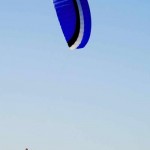 Picking the right kite can be a chore. Kite size will vary with rider weight and wind conditions. If unsure which is best, consult your local kite dealer. Kites used for KGB tend to be larger for a given wind range than ones used to buggy. Check the average wind speed for the location you most often use. Look for a kite that has a wind range that best matches the local conditions. Remember wind speed averages may change drastically from season to season. In most cases, winter and spring will call for smaller kites for higher wind speeds and summer and early fall will require very large kites to get you moving.
Picking the right kite can be a chore. Kite size will vary with rider weight and wind conditions. If unsure which is best, consult your local kite dealer. Kites used for KGB tend to be larger for a given wind range than ones used to buggy. Check the average wind speed for the location you most often use. Look for a kite that has a wind range that best matches the local conditions. Remember wind speed averages may change drastically from season to season. In most cases, winter and spring will call for smaller kites for higher wind speeds and summer and early fall will require very large kites to get you moving.
If figuring kite size from your weight, skill, and local average wind conditions was not a challenge here is another. You must decide if you want to use handles, a bar, or a depowerable kite on a bar with a harness. The choice between handles or a bar is a personal preference. I chose a bar for the easy of which you could do one handed tricks and grabs, others prefer handles for more precise control of the kite. Kites like the Ozone Samurai come standard with a choice of either bars or a handle and make a great choice for the beginner kiteboarder.
To start, I would not fly with a harness. Being hooked into the kite takes some getting used to. Your concentration to begin with will be flying the kite, and you will not have time to detach if something goes wrong. After you are very comfortable with flying the kite, I suggest you invest in a harness. Your arms will thank you. An hour of flying in strong winds without a harness and my arms would be putty. With a harness you can fly much longer and are free to do more tricks. A harness allows one to use depowerable kites like the Ozone Frenzy that greatly extend the wind range for a given kite and allow for better absorption of gusts.
The board is an easier choice. The three main components to examine are the deck (the wood area you stand on), the trucks (a device used to attach the wheels), and the wheels. I prefer boards produced by an American company, Ground Industries. They are pushing out innovative designs and really pushing for lighter more controllable boards. They use a new truck design called the T3 that is unlike anything I have seen before in comparison to weight and maneuverability.
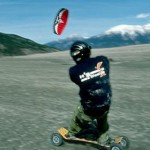 Other American made choices would be Mongoose and Hyline that are made by the same manufacturer. The later two come with a choice of skate or channel trucks. Skate trucks closely resemble those used on a skateboard and are known for their lightness. Channel trucks use a double spring system and seem to absorb rough terrain well, but compromise is made in their extra weight. There are a variety of other brands of varying quality, most of which come with either skate or channel trucks. One last major difference in boards is the “Kite specific” board. The “Kite specific” board inherently points the board in an upwind direction. This feature is ok when riding with a kite, but makes it useless for any other all terrain riding since it always wants to veer toward one direction.
Other American made choices would be Mongoose and Hyline that are made by the same manufacturer. The later two come with a choice of skate or channel trucks. Skate trucks closely resemble those used on a skateboard and are known for their lightness. Channel trucks use a double spring system and seem to absorb rough terrain well, but compromise is made in their extra weight. There are a variety of other brands of varying quality, most of which come with either skate or channel trucks. One last major difference in boards is the “Kite specific” board. The “Kite specific” board inherently points the board in an upwind direction. This feature is ok when riding with a kite, but makes it useless for any other all terrain riding since it always wants to veer toward one direction.
Cost:
Now that you have your shopping list complete, here is what everything may cost… Based on some of my personal suggestions, prices are approximate.
Beginner kit:
Trainer kite (can be used as a high wind kite later), suggested kite Ozone Little Devil 1.5 meter w/lines and handles – $180
Ozone Samurai 3.0 meter kite w/lines and handles or bar- $300
Ground Industries Patrol Deck Ground Board – $329.99
Or, Mongoose also makes a cheap board – $150
Pro-Tec Helmet – $30.00
Knee Pads – $25.00
Elbow Pads – $19.99
You can get rolling with a beginner ground boarding kit for around $705 total.
Advanced kit:
Ozone Frenzy 7.3 meter kite w/lines and bar – $799.99
Ground Industries Flight Offstreet – $299.99
Waist Harness – $90.00
Pro-Tec Helmet – Roughly $30.00
Knee Pads – $25.00
Elbow Pads – $19.99
This Advanced kit runs about $1,265 total.
Where to Ride:
First of ensure there are no power lines anywhere near your field. When things go wrong you can be dragged futher than you may expect, so add this to your spacing. I use primarly soccer fields, many kiters on the coasts use the hard packed sand on beaches. Too high of grass or too soft of sand make it difficult to ride.
Combining extended flights and the ground speed, kite groundboarding would seem to have everything the adrenaline junky could need. The rush does come at a price, the addiction is severe.
William Leady
For more info on Kite Groundboarding please visit:
Tempest Riders is here to bring you the latest pictures, videos, gear reviews, faqs, local kite spots, weather links, kiteboarding and power kite links, competition info, tips on riding techniques, and is dedicated to promoting Power Kiting. The site specializes in kitegroundboarding (aka kiteatb, landboarding, kiteboarding, kite mountainboarding)



